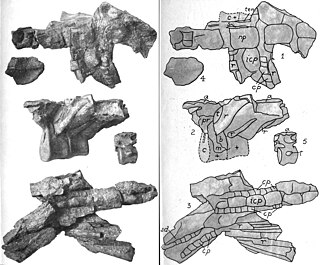
Nodosaurus is a genus of herbivorous nodosaurid ankylosaurian dinosaur from the Late Cretaceous, the fossils of which are found in North America.

Gargoyleosaurus is one of the earliest ankylosaurs known from reasonably complete fossil remains. Its skull measures 29 centimetres (11 in) in length, and its total body length is an estimated 3 to 4 metres. It may have weighed as much as 1 tonne (2,200 lb), or as little as 300 kilograms. The holotype was discovered in 1995 at the Bone Cabin Quarry West locality, in Albany County, Wyoming in exposures of the Upper Jurassic Morrison Formation.

Aletopelta coombsi is an herbivorous ankylosaurian ornithischian dinosaur that during the Late Cretaceous lived in the area of what is now Southern California.
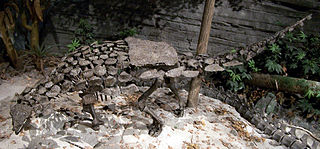
Nodosauridae is a family of ankylosaurian dinosaurs, from the Late Jurassic to the Late Cretaceous period of the Northern Hemisphere, in what are now North America, Europe, and Asia.
Texasetes is a genus of ankylosaurian dinosaurs from the late Lower Cretaceous of North America. This poorly known genus has been recovered from the Paw Paw Formation near Haslet, Tarrant County, Texas, which has also produced the nodosaurid ankylosaur Pawpawsaurus. Texasetes is estimated to have been 2.5–3 m (8–10 ft) in length. It was named by Coombs in 1995.
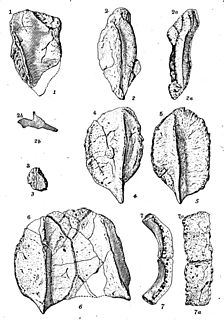
Hierosaurus is an extinct genus of nodosaurid ankylosaur which lived during the Late Cretaceous 87 to 82 million years ago. Its fossils were found in the Smoky Hill Chalk Member of the Niobrara Formation, in western Kansas, which would have been near the middle of the Western Interior Sea during the Late Cretaceous. It was a nodosaurid, an ankylosaur without a clubbed tail.

Mymoorapelta is an ankylosaur from the Late Jurassic (Kimmeridgian-Tithonian) Morrison Formation of western Colorado, USA. The taxon is known from portions of a disarticulated skull, parts of three different skeletons and other postcranial remains. It is present in stratigraphic zones 4 and 5 of the Morrison Formation.
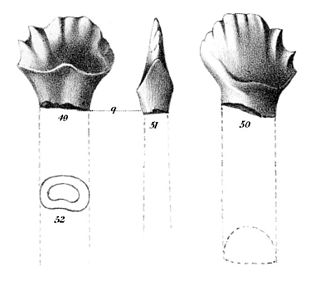
Palaeoscincus is a dubious genus of ankylosaurian dinosaur based on teeth from the mid-late Campanian-age Upper Cretaceous Judith River Formation of Montana. Like several other dinosaur genera named by Joseph Leidy, it is an historically important genus with a convoluted taxonomy that has been all but abandoned by modern dinosaur paleontologists. Because of its wide use in the early 20th century, it was somewhat well known to the general public, often through illustrations of an animal with the armor of Edmontonia and the tail club of an ankylosaurid.

Antarctopelta was a genus of ankylosaurian dinosaur with one known species, A. oliveroi, which lived in Antarctica during the Late Cretaceous Period. It was a medium-sized ankylosaur, reaching no more than 4 meters (13 ft) in length, and showed characteristics of two different families, making more precise classification difficult. The single known fossil specimen was discovered on James Ross Island in 1986, constituting the first dinosaur remains ever discovered on Antarctica, although it is the second dinosaur from the continent to be formally named.
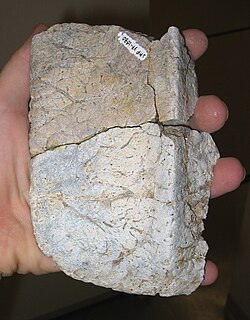
Glyptodontopelta is a genus of dinosaur from the Late Cretaceous. It was a nodosaur, an armored dinosaur.

Priconodon is an extinct genus of dinosaur, known from its large teeth. Its remains have been found in the Aptian-Albian age Lower Cretaceous Arundel Formation of Muirkirk, Prince George's County, Maryland, USA and the Potomac Group, also located in Maryland.

The Paw Paw Formation is a geological formation in Texas whose strata date back to the late Albian stage of the Early Cretaceous. Dinosaur remains are among the fossils that have been recovered from the formation.
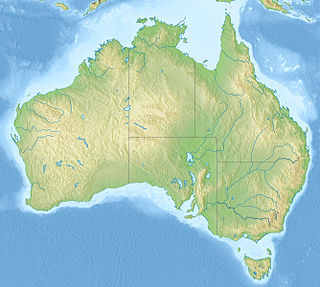
The Allaru Formation, also known as the Allaru Mudstone, is a geological formation in Queensland, Australia, whose strata date back to the Early Cretaceous. Dinosaur remains are among the fossils that have been recovered from the formation.
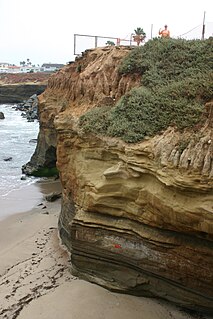
The Point Loma Formation is a sedimentary geological formation in Southern California. The strata date back to the Late Cretaceous epochs of the Cretaceous period, during the Mesozoic Era.

The Calcare di Altamura is a Coniacian to early Campanian geologic formation in Italy. The formation comprises limestones that are highly fractured, in places karstified and dolomitized. Fossil ankylosaur tracks have been reported from the formation.

The Plainview Formation is a Early Cretaceous (Albian) geologic formation of the Dakota Group in Colorado. Fossil ankylosaur tracks and tracks of Caririchnium sp. have been reported from the formation.
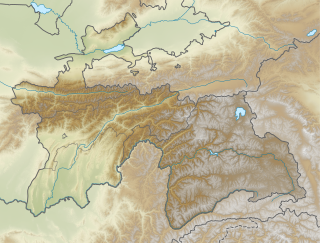
The Shirabad Formation is a late Albian geologic formation in Tajikistan.
The Tantalus Formation is a Mesozoic geologic formation in Canada. Fossil ankylosaur tracks have been reported from the formation.
The Tecocoyunca Group is a Mesozoic geologic formation in Mexico. Fossil sauropod tracks have been reported from the formation.

This timeline of ankylosaur research is a chronological listing of events in the history of paleontology focused on the ankylosaurs, quadrupedal herbivorous dinosaurs who were protected by a covering bony plates and spikes and sometimes by a clubbed tail. Although formally trained scientists did not begin documenting ankylosaur fossils until the early 19th century, Native Americans had a long history of contact with these remains, which were generally interpreted through a mythological lens. The Delaware people have stories about smoking the bones of ancient monsters in a magic ritual to have wishes granted and ankylosaur fossils are among the local fossils that may have been used like this. The Native Americans of the modern southwestern United States tell stories about an armored monster named Yeitso that may have been influenced by local ankylosaur fossils. Likewise, ankylosaur remains are among the dinosaur bones found along the Red Deer River of Alberta, Canada where the Piegan people believe that the Grandfather of the Buffalo once lived.















